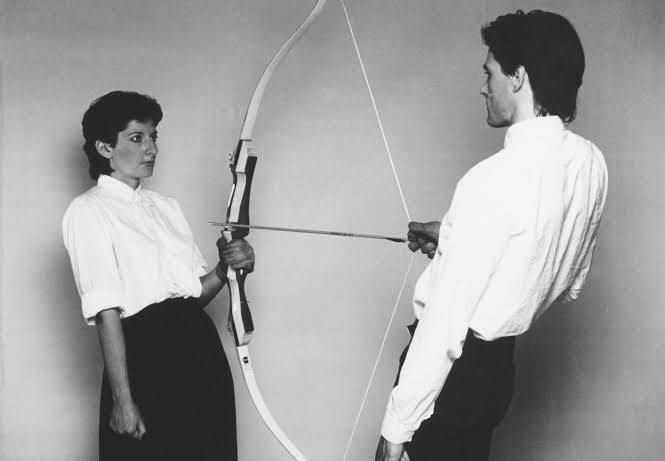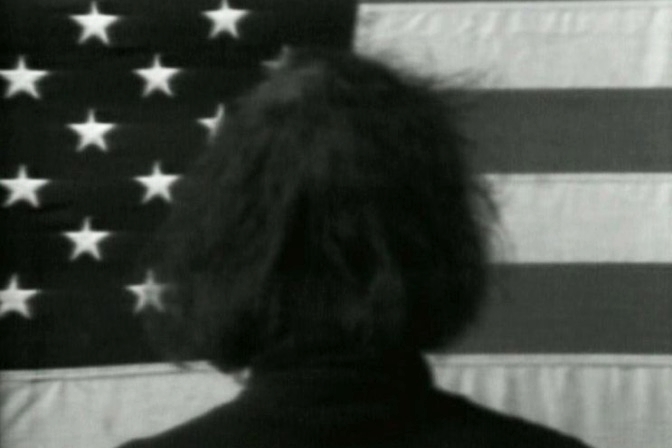Video and Performance: Marina Abramović and Ulay is a single-channel programme of several works by the legendary couple in performance art – Marina Abramović and Ulay (b. 1946 Belgrade, Serbia), (b.1943 – d. 2020 Solingen, Germany),
Marina Abramović and Ulay (Frank Uwe Laysiepen) started collaborating as artists and living together in 1976. Their separation was marked by the famous The Lovers: Great Wall Walk performance in China, in 1988. Over and over again, they have made themselves the topic of their performances and actions, exploring the limits of physical and psychic endurance and specific gender roles. In 1975, Abramović and Ulay defined the aspects of this project as follows: “Art Vital – no fixed living place, permanent movement, direct contact, local relation, self-selection, passing limitations, taking risks, mobile energy, no rehearsal, no predicted end, no repetition.” They blurred the line between art and life, especially considering how often real danger becomes part of their artistic concept.
The televised studio performance AAA-AAA, with no audience in Liege, shows Abramović and Ulay yelling at each other. The performance was a follow-up to Freeing the Voice (Abramovic, 1976), in which Abramović shouted herself hoarse. But while the purification of body and mind used to be crucial, AAA-AAA centres on the relationship between two lovers. They started from an equal position to end up outdoing each other. As in many cases, the performance was repeated to be filmed a year after its original creation in Amsterdam by Louis van Gasteren, for documentation purposes.
The performance Relation in Time, which took place at Studio G7 in Bologna, Italy, is part of the performance series entitled That Self, which evokes a third entity born from the interaction of male and female energies. Abramović and Ulay were tied together by their hair, each looking in a different direction. They sat alone in silence for the first sixteen hours and visitors were allowed to attend the final hour. John Cage, a great influence for Ulay and Abramovic, called this “activity within inactivity.” The process was heavily demanding for both the physical and mental stamina of the artists, who were looking for harmony between body and mind as well as equilibrium between genders. This action revolves around the concept of polarity and tends to create an androgynous creature.
Breathing in / Breathing out pursues this question of duality. In this performance, recorded in April 1977 in Belgrade, Ulay and Abramović depend desperately on each other to stay alive for almost twenty minutes. Connected by their mouths, they share their breaths without external access to oxygen and end up collapsing. This action metaphorically deals with the death of the self that is always at stake in collaborative work. This action is a symbolic attempt to unite and absorb one another’s lives until their destruction.
Rest Energy, recorded in 1980 at Filmstudio Amsterdam, is also part of the That Self series and engages with the first acceptance of performance when understood as a body test that can lead to endangering life. Ulay and Abramovic drew a large bow and arrow, each holding one side. The arrowhead was pointing at Abramovic’s heart, creating a dense tension. Microphones on their clothes picked up their quickening heartbeats and irregular breathing. After four minutes, they dropped the bow.
In their final and penultimate performance, Marina Abramović and Ulay undertook their ultimate collaboration: The Lovers: Great Wall Walk. They proposed to be the first people to walk the Great Wall of China. Setting off alone from opposite ends, they planned to meet in the middle, where they would marry. Abramović and Ulay began their walks on 30 March 1988, from either end of the Great Wall, known to the Chinese as The Sleeping Dragon. Abramović set off westwards from the dragon’s head at the Bohai Sea, an extension of the Yellow Sea between China and the Korean peninsula. They saw The Lovers as an odyssey and a performance in which they alone would be both players and audience.
Marina Abramović (b. 1946) was born in Belgrade in former Yugoslavia and is now based in New York, US. She began her work as a performance artist in the 1970s and is now regarded as one of the most important artists in the field. Her work explores the relationship between performer and audience, the limits of the body and the possibilities of the mind. In 2017 the retrospective ‘The Cleaner’ was shown at Moderna Museet in Stockholm, Sweden, and Louisiana Museum of Modern Art in Humlebæk, Denmark, among other places.
Ulay (Frank Uwe Laysiepen, b.1943 – d. 2020) is a German artist, who was based in Amsterdam, Holland, and Ljubljana, Slovenia. Ulay received international recognition for his work as a photographer, mainly in Polaroid, from the late 1960s, and later as a performance artist, including his collaborative performances with Marina Abramović from 1976 to 1988. His work has continuously dealt with politics, identity and gender. In 2016 Schirn Kunsthalle in Frankfurt, Germany, held the first major retrospective show of his work ‘Ulay Life-Sized’.
Video and Performance: Marina Abramović and Ulay was curated by Film and Video Umbrella with funding from Arts Council England.










